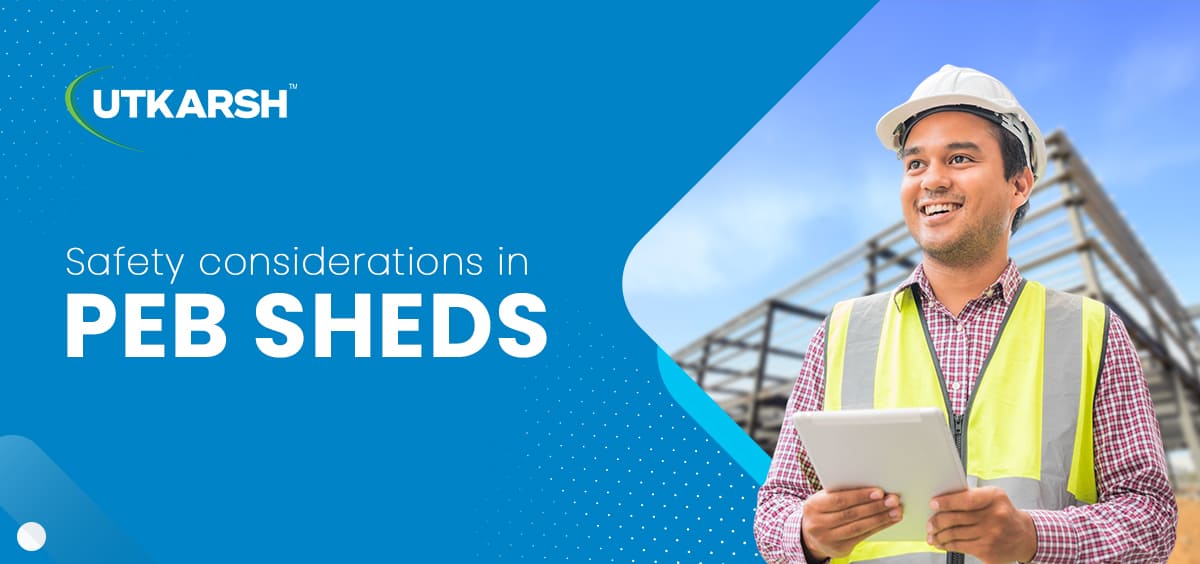Safety considerations in PEB sheds

A Pre-engineered Building (PEB) shed is composed of prefabricated sections that are manufactured off-site and then assembled on-site. These structures have a built-in framing system and are significantly lighter than traditional sheds. PEB sheds are produced using a single design that incorporates different materials to meet diverse structural demands in various industries, such as warehouses, factory sheds, and agricultural sheds. During the design process, it is important to consider a range of safety factors to guarantee the well-being of workers, equipment, and the structure as a whole. The following are some of the essential considerations:
Wind Load:
The term 'Wind Load' pertains to the pressure exerted by wind on the PEB structure. The wind load on a PEB can have a significant impact on its stability and safety. The three types of wind forces that can act on a building are :
Uplift load: It refers to the wind flow pressure that can create a lifting effect on the roof which is similar to the lift generated on aeroplane wings. When strong winds blow over a roof, the wind flow creates a low-pressure zone that tends to pull the roof upwards, while the gush of wind under the roof creates a high-pressure zone that pushes the roof upwards.
Shear load: It refers to the horizontal wind pressure causing the walls to rack or tilt.
Lateral load: It refers to the horizontal pushing and pulling pressure on walls that can make a structure slide off the foundation or even overturn
Seismic Load:
It refers to the level of seismic energy or waves of energy that travel through the earth that a PEB structure would need to endure in a specific geographic location. While designing a PEB shed, it is important to consider the location, soil condition and building requirements. For instance, if the PEB shed is being installed in an area that experiences frequent seismic activities, materials used for construction should be sturdy and earthquake-resistant. For instance, steel and concrete are the ideal manufacturing materials for such conditions. There are several parameters to calculate seismic loads. Some of them include:
Earthquake parameters at the building site include soil type, slope and frequency of seismic activities.
The building characteristics include the type of materials used, the height and shape of the structure that can withstand the magnitude of the earthquake.
The construction quality of the building such as its damping ratio, natural frequency and the weight of the structure.
Conventional buildings made of masonry tend to be more brittle and can suffer severe damage or even collapse during an earthquake. In contrast, PEB structures typically include steel, which is a more ductile material, allowing the structure to flex and absorb seismic energy without suffering significant damage.
Fire Safety:
Because PEB sheds are constructed using fire-rated materials such as steel or concrete, they can be less likely to catch fire than traditional building materials like wood. Also, it is important to maintain fire safety measures inside PEB sheds. They must be equipped with fire fighting supplies such as fire alarms, fire hydrants and sprinklers. Regular inspections must be carried out to spot any leaks and damages that might cause fire. PEB sheds must have adequate ventilation and fire resistant storage for the hazardous items in the warehouse.
Electrical Safety:
PEB sheds can be made electrically safe if proper electrical installations, grounding, and maintenance are carried out. Electrical hazards such as shocks and fires can be prevented by ensuring that wiring and panels are done by qualified electricians in compliance with electrical codes and safety regulations. The electrical equipment such as motors, generators, and transformers should also be installed, grounded, and regularly maintained to prevent potential hazards.
In addition, electrical load calculations should be carried out before setting up safety rules and regulations inside the PEB shed, and workers should receive appropriate electrical training to identify potential hazards and handle emergency situations.
Looking for PEB shed manufacturers in India?
If you are looking for PEB manufacturing companies, explore Utkarsh India Limited. Our design skills and work are approved by coveted bodies such as IITs. Indian Railways, PHED and SGS among many. Our PEB structures are made from highly durable and galvanised material which conform to grade standards IS2062 and ASTM572. As one of the leading PEB manufacturers, we continue to work closely with major clients all around the globe such as JIO, ADANI, L&T, IL & FS and many more. We have a fabrication capacity of 25k metric tons per month. All our operations, quality checks and testing are done in-house.
Read more : Our latest PEB building project - N.S. Power’s industrial shed